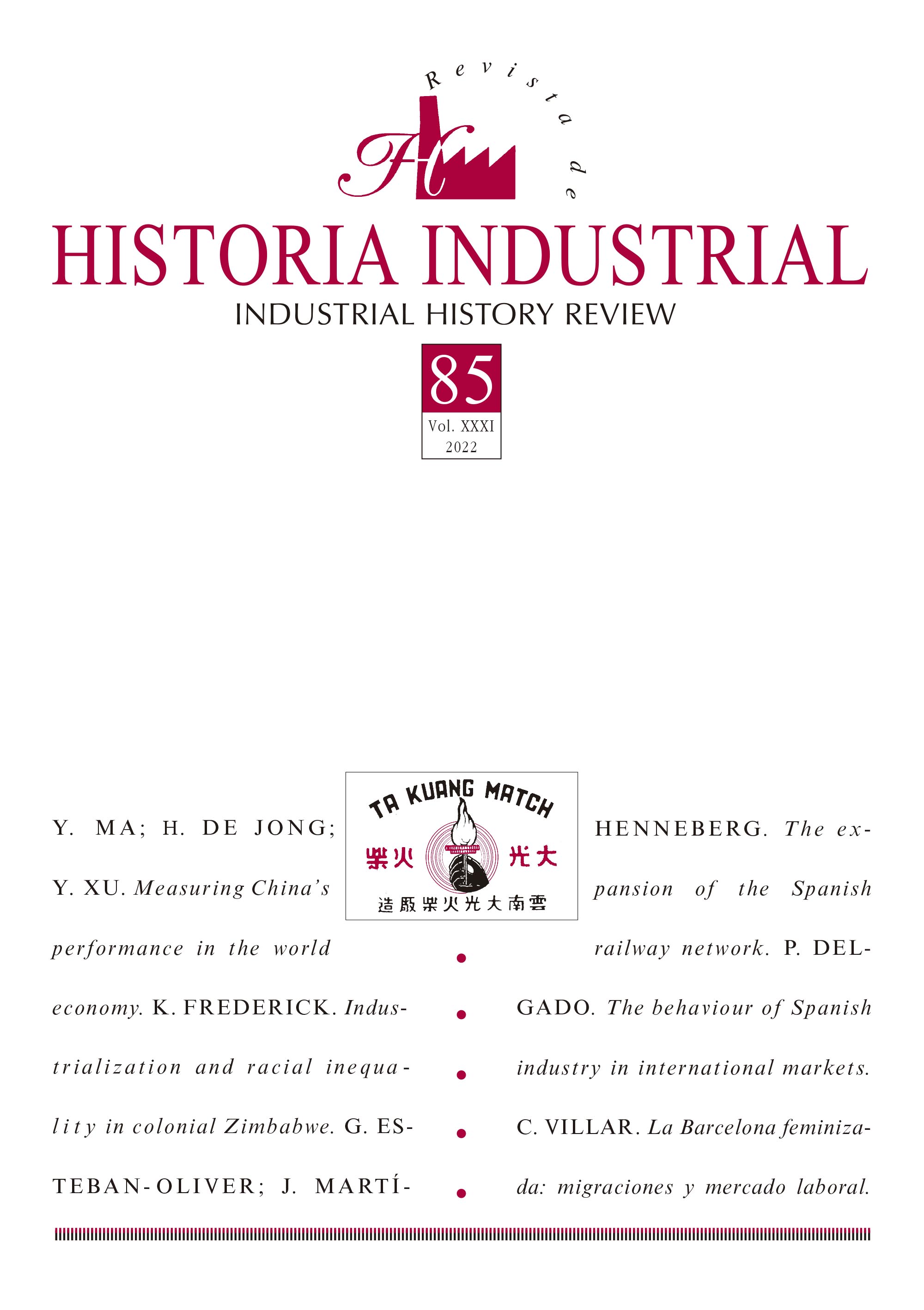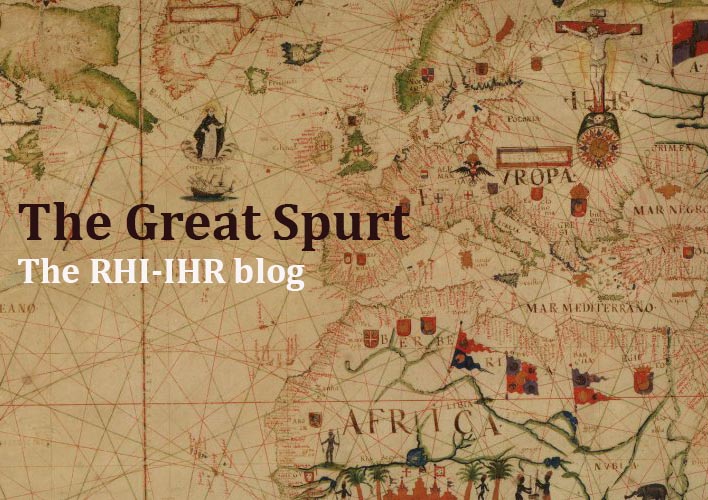The production of precarity: industrialization and racial inequality in colonial Zimbabwe
DOI:
https://doi.org/10.1344/rhiihr.38047Keywords:
colonialism, industrialization, urbanization, racial inequalityAbstract
During the mid-twentieth century, the colony of Southern Rhodesia (today Zimbabwe) underwent a rapid process of industrial development, leading tens of thousands of black African men to leave overcrowded rural Reserves in search of better economic prospects in burgeoning industrial cities. Cities in Southern Rhodesia promised higher wages relative to rural areas, but many urban black labourers found themselves in precarious economic positions. Few black industrial workers earned wages sufficient to support an urban family; meanwhile, white industrial workers secured wage rates ten times higher, afforded by colonial institutions geared primarily toward serving the needs of white European settlers. This study zooms in on the foundations and consequences of racial inequality in industrializing Southern Rhodesia and also considers the settler colony in comparative perspective relative to other sub-Saharan African colonies – both settler and non-settler – to draw attention to the interplay between economic development, institutions, and inequality in a colonial context.
Downloads
References
Alexander, Jocelyn. 2012. “’Hooligans, Spivs and Loafers?’: The Politics of Vagrancy in 1960s Southern Rhodesia”, Journal of African History 53 (2): 345-366.
Alexopoulou, Kleoniki and Dácil Juif. 2017. “Colonial State Formation Without Integration: Tax Capacity and Labour Regimes in Portuguese Mozambique”, International Review of Social History 62: 215-252.
Arrighi, Giovanni. 1967. The Political Economy of Rhodesia. The Hague: Mouton.
Arrighi, Giovanni. 1970. “Labour Supplies in Historical Perspective: A Study of the Proletarianization of the African Peasantry in Rhodesia”, Journal of Development Studies 6 (3): 197-234.
Austin, Gareth, Ewout Frankema, and Morten Jerven. 2017. “Patterns of Manufacturing Growth in Sub-Saharan Africa: From Colonization to Present”. In The Spread of Modern Industry to the Periphery since 1871, edited by Kevin Hjortshøj O’Rourke and Jeffrey Gale Williamson, 345-374. Oxford: Oxford University Press.
Barnes, Teresa. 1995. “So That a Labourer Could Live with His Family’: Overlooked- Factors in Social Economic Strife in Urban Colonial Zimbabwe, 1945-1952”, Journal of Southern African Studies 21 (1): 95-113.
Batson, Edward. 1945. “The Poverty Line in Salisbury”. Report no. SBY 3. Social Survey of Salisbury, Southern Rhodesia. Cape Town: University of Cape Town.
Bettison, D. G. 1958. “The Socio-Economic Circumstances of a Sample of Africans in Salisbury, July, 1957”. In Report of the Urban African Affairs Commission, 1958, edited by Robert Percival Plewman, William Margolis, Leslie Benjamin Fereday, James Scott Brown and Herbert Wiltshire Chitepo, 180-194. Salisbury: Government Printer.
Bettison, D. G. 1960. “Factors in the Determination of Wage Rates in Central Africa”, The Rhodes-Livingstone Journal 28: 22-46.
Clarence-Smith, William Gervase. 1989. “The Effects of the Depression on Industrialization in Equatorial and Central Africa”. In The Economies of Africa and Asia in the Interwar Depression, edited by Ian Brown, 170-202. London/New York: Routledge.
Clarke, D. G. 1974. Contract Workers and Underdevelopment in Rhodesia. Gwelo: Mambo Press.
Cubitt, Verity S., and Roger C. Riddell. 1974. The Urban Poverty Datum Line in Rhodesia: A Study of the Minimum Consumption Needs of Families. Salisbury: University of Rhodesia.
De Haas, Michiel. 2017. “Measuring Rural Welfare in Colonial Africa: Did Uganda’s Smallholders Thrive?”, Economic HIstory Review 70 (2): 605-631.
Duggan, William R. 1980. “The Native Land Husbandry Act of 1951 and the Rural African Middle Class of Southern Rhodesia”, African Affairs 79 (315): 227-239.
Federation of Rhodesian Industries. 1954. First Interim Report on Rhodesian Industry. Salisbury: Federation of Rhodesian Industries.
Feinstein, Charles H. 2005. An Economic History of South Africa: Conquest, Discrimination, and Development. New York: Cambridge University Press.
Floyd, Barry N. 1962. “Land Apportionment in Southern Rhodesia”, Geographical Review 52 (4): 566-582.
Frankema, Ewout, and Marlous van Waijenburg. 2012. “Structural Impediments to African Growth? New Evidence from Real Wages in British Africa, 1880-1965”, Journal of Economic History 72 (4): 895-926.
Frederick, Katharine, and Elise van Nederveen Meerkerk. 2022. “From Temporary Urbanites to Permanent City Dwellers? Rural-Urban Labor Migration in Colonial Southern Rhodesia and the Belgian Congo”. In Migration in Africa: Shifting Patterns of Mobility from the 19th to the 21st Century, edited by Michiel de Haas and Ewout Frankema, 256-280. Abingdon; New York: Routledge.
Gallardo-Albarrán, Daniel and Herman de Jong. 2021. “Optimism or Pessimism? A Composite View on English Living Standards During the Industrial Revolution”, European Review of Economic History 25: 1-19.
Gargett, Eric. 1977. The Administration in Transition: African Urban Settlement in Rhodesia. Gwelo: Mambo Press.
Gollin, Douglas, Remi Jedwab, and Dietrich Vollrath. 2016. “Urbanization with and without Industrialization”, Journal of Economic Growth 21 (1): 35-70.
Gray, Richard. 1960. The Two Nations: Aspects of the Development of Race Relations in the Rhodesias and Nyasaland. London: Oxford University Press.
Harris, Peter. 1974. Black Industrial Workers in Rhodesia: The General Problems of Low Pay. Gwelo: Mambo Press.
Harris, Peter. 1975. “Industrial Workers in Rhodesia, 1946–1972: Working-Class Elites or Lumpenproletariat?”, Journal of Southern African Studies 1 (2): 139-161.
Howman Committee. 1945. “Report on Urban Conditions in Southern Rhodesia”, African Studies 4 (1): 9-22.
Ibottson, Percy. 1946. “Urbanization in Southern Rhodesia”, Africa 16 (1): 73-82.
Juif, Dácil. 2022. “Migration and Stabilization: Mining Labor in the Belgian Congo, Northern Rhodesia, and South Africa”. In Migration in Africa: Shifting Patterns of Mobility from the 19th to the 21st Century, edited by Michiel De Haas and Ewout Frankema, 203-228. Abingdon; New York: Routledge.
Juif, Dácil, and Ewout Frankema. 2018. “From Coercion to Compensation: Institutional Responses to Labour Scarcity in the Central African Copperbelt”, Journal of Institutional Economics 14 (2): 313-343.
Kniivilä, Matleena. 2007. “Industrial Development and Economic Growth: Implications for Poverty Reduction and Income Inequality”. In Industrial Development for the 21st Century: Sustainable Development Perspectives, edited by JoAnne DiSano, 295-332. New York: United Nations.
Lewis, W. Arthur. 1954. “Economic Development with Unlimited Supplies of Labour”, The Manchester School 2: 139-191.
McEwan, Peter J. 1963. “The European Population of Southern Rhodesia”, Civilisations 13 (4): 429-444.
Meier zu Selhausen, Felix. 2022. “Urban Migration in East and West Africa since 1950: Contrasts and Transformations”. In Migration in Africa: Shifting Patterns of Mobility from the 19th to the 21st Century, edited by Michiel de Haas and Ewout Frankema, 281-307. Abingdon; New York: Routledge.
Mlambo, A. S. 2009. “From the Second World War to UDI, 1940-1965”. In Becoming Zimbabwe: A History from the Pre-Colonial Period to 2008, edited by Brian Raftopoulos and Alois Mlambo, 75-114. Harare: Weaver Press.
Mosley, Paul. 1983. The Settler Economies: Studies in the Economic History of Kenya and Southern Rhodesia, 1900-63. Cambridge: Cambridge University Press.
Mtisi, Joseph, Munyaradzi Nyakudya, and Teresa Barnes. 2009. “Social and Economic Developments During the UDI Period”. In Becoming Zimbabwe: A History from the Pre-Colonial Period to 2008, edited by Brian Raftopoulos and Alois Mlambo, 115-140. Harare: Weaver Press.
Palmer, Robin. 1977. Land and Racial Domination in Rhodesia. Berkeley; Los Angeles: University of Calfornia Press.
Phimister, Ian. 1988. An Economic and Social History of Zimbabwe, 1890–1948: Capital Accumulation and Class Struggle. New York: Longman.
Phimister, Ian. 1993. “Rethinking the Reserves: Southern Rhodesia’s Land Husbandry Act Reviewed”, Jounal of Southern African Studies 19: 225-239.
Phimister, Ian, and Victor Gwande. 2017. “Secondary Industry and Settler Colonialism: Southern Rhodesia before and after the Unilateral Declaration of Independence”, African Economic History 45 (2): 85-112.
Phimister, Ian, and Rory Pilossof. 2017. “Wage Labor in Historical Perspective: A Study of the De-Proletarianization of the African Working Class in Zimbabwe, 1960-2010”, Labor history 58 (2): 215-227.
Phimister, Ian, and Brian Raftopoulos. 2000. “‘Kana Sora Ratswa Ngaritswe’: African Nationalists and Black Workers – the 1948 General Strike in Colonial Zimbabwe”, Journal of Historical Sociology 13 (3): 289-324.
Plewman, Robert Percival, William Margolis, Leslie Benjamin Fereday, James Scott Brown, and Herbert Wiltshire Chitepo, eds. 1958. Report of the Urban African Affairs Commission, 1958. Salisbury: Government Printer.
Raftopoulos, Brian, and Tsuneo Yoshikuni. 1999. “Introduction”. In Sites of Struggle: Essays in Zimbabwe’s Urban History, edited by Brian Raftopoulos and Tsuneo Yoshikuni, 1-18. Harare: Weaver Press.
Rempel, Henry. 1981. Rural-Urban Labor Migration and Urban Unemployment in Kenya. Laxenburg: International Institute for Applied Systems Analysis.
Rodney, Walter 1972. How Europe Underdeveloped Africa. Redhill: Love and Malcomson.
Rostow, WW. 1962. The Stages of Economic Growth. London: Cambridge University Press.
Scott, Peter. 1954. “Migrant Labour in Southern Rhodesia”, Geographical Review 44 (1): 29-48.
Secretary for Internal Affairs and Chief Native Commissioner. 1963. Report of the Secretary for Internal Affairs and Chief Native Commissioner for the Year 1962. Salisbury: Government Printer.
Secretary for Labour and Social Welfare. 1964. Report of the Secretary for Labour and Social Welfare for the Year Ended 31st December, 1963. Salisbury: Government Printer.
Secretary for Labour, Social Welfare and Housing. 1959. Report of the Secretary for Labour, Social Welfare and Housing for the Year Ended 31st December, 1958. Salisbury: Government Printer.
Secretary for Labour, Social Welfare and Housing. 1961. Report of the Secretary for Labour, Social Welfare and Housing for the Year Ended 31st December, 1960. Salisbury: Government Printer.
Southern Rhodesia. 1943. Official Report. Southern Rhodesia Debates of the Legislative Assembly. Vol. 23, No. 31, 11 June 1943. Salisbury: Parliamentary Printers.
Southern Rhodesia. 1955. Thirteenth Report on the Census of Industrial Production, 1938-1953. Salisbury: Central African Statistical Office.
Southern Rhodesia. 1959. Second Report on Urban African Budget Survey in Salisbury, 1957/58. Salisbury: Central African Statistical Office.
Southern Rhodesia. 1964. Final Report of the April/May 1962 Census of Africans in Southern Rhodesia. Salisbury: Central Statistical Office.
Southern Rhodesia. no date. The Census of Production in 1966. Mining, Manufacturing, Construction, Electricity and Water Supply. Salisbury: Central Statistical Office.
Vail, Leroy. 1975. “The Making of an Imperial Slum: Nyasaland and Its Railways, 1895-1935”, Journal of African History 16 (1): 89-112.
Van Zwanenberg, R. 1972. “History and Theory of Urban Poverty in Nairobi: The Problem of Slum Development”. Discussion Paper 139. Institute for Development Studies working paper series. Nairobi: University of Nairobi.
Vickery, Kenneth P. 1999. “The Rhodesia Railways African Strike of 1945, Part II: Causes, Consequence, Significance”, Journal of Southern African Studies 25 (1): 49-71.
Weinrich, A. K. H. 1979. Women and Racial Discrimination in Rhodesia. Paris: UNESCO.
Williamson, Jeffrey G. 2011. Trade and Poverty: When the Third World Fell Behind. Cambridge: MIT Press.
Zinyama, Lovemore, and Richard Whitlow. 1986. “Changing Patterns of Population Distribution in Zimbabwe”, GeoJournal 13 (4): 365-384.
Downloads
Published
How to Cite
Issue
Section
License
Copyright (c) 2019 Revista de Historia Industrial – Industrial History Review

This work is licensed under a Creative Commons Attribution 4.0 International License.
We have been applying a Creative Commons Attribution license (CC-BY) since 2019, before that year we had a partial open access policy, which included open access for the first two months after publication, followed by an embargo policy for non-subscribers, as access to the last 4 published issues was restricted to journal subscribers. In contrast, early-view articles were always open access prior to publication in an assigned volume. Until 2024 the access to the last 4 published numbers was restricted to those who were subscripted to the journal.
The author assigns all rights to the publisher. Creative Commons
The author who publishes in this journal agrees to the following terms:
- The author assigns all intellectual property rights exclusively to the publisher for the entire duration of the applicable intellectual property rights. The University of Barcelona holds the copyright ownership of the contents published in the journal.
- The publisher will distribute the texts under the Creative Commons Attribution License, which allows others to share the work, provided that they acknowledge the authorship, its initial publication in this journal, and the conditions of the license.





